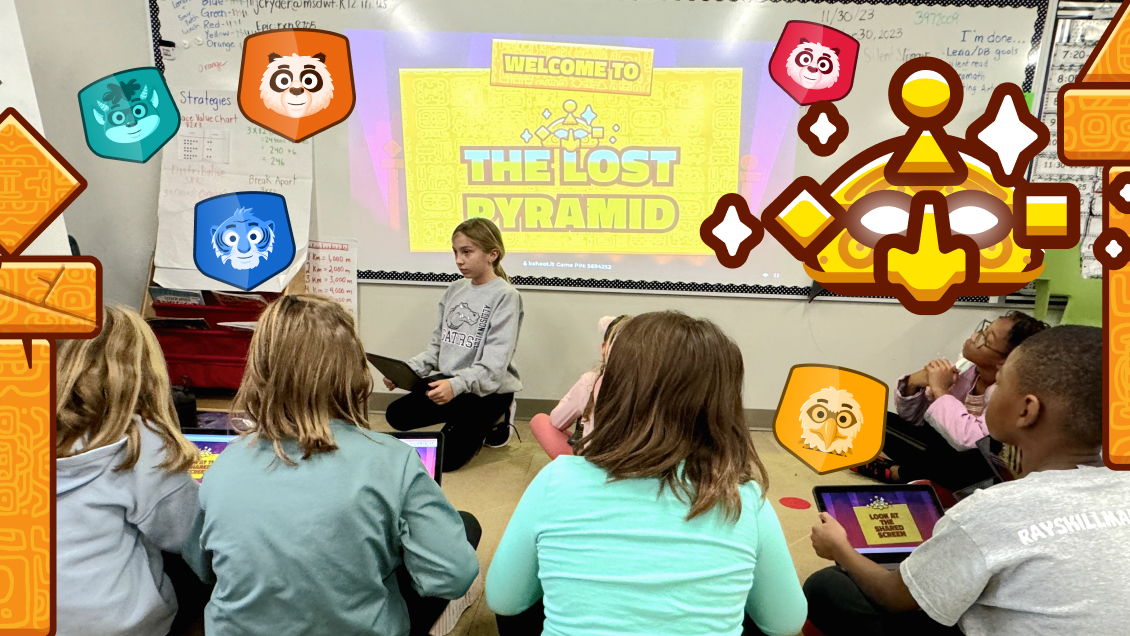
By combining critical thinking with subject-specific instruction, players and hosts enhance their understanding through teamwork, trust, and collaboration. Kahoot! Ambassadors have been trying out our new game mode, The Lost Pyramid, to offer helpful advice and effective methods for introducing this style of play to your classroom. Continue reading to discover their personal expertise and classroom insights.
The new game mode, The Lost Pyramid, specifically, prompts a team-focused, collaborative learning experience. Here’s how:
- Players join a live game, self-selecting a team. Hosts can update teams with specific player rosters. As rosters are confirmed, players can collectively brainstorm and update their own team names.
- Hosts initiate gameplay, and the first prompt is presented on both a host screen, as well as individual player screens. The question timer is automatically set to 100 seconds, providing ample time for group thinking and personal reflection.
#KahootTip Before gameplay begins, organize students into group spaces – whether virtually or in designated spaces across the classroom. This ensures teams have space to discuss and collaborate! - Individual teams convene to discuss and consider their group response. Players may choose different answers, though the majority response is determined as the final answer.
- Review and reflect on the selected answer, considering the opportunities to risk an incorrect response, or be rewarded for a correct answer! Players independently wager their choices with point values.
- Wager your way to the top of the pyramid during the duration of gameplay! Each question is a new opportunity to forge ahead or be knocked off course. Choose wisely!
As with any classroom experience, designing an instructional space that supports and celebrates student success is crucial. Kahoot! Teachers of Awesome suggest the following best practices.
Cultivate collaboration and curiosity
Reintroducing a topic after time away? Prompting background knowledge before presenting a new concept? The conversation component of The lost pyramid helps to exponentially increase student engagement and learning activation! After every presented question, players strategy game play halts to allow ample time for conversation, reflection and discussion. No matter the level or achievement of each individual students’ comprehension, this standalone conversation time allows players to bounce ideas off one another, pose prompting questions to foster comprehension, and stimulate critical thinking as they reason between the rationale of their peers’ ideas. “The Lost Pyramid is a great way to get students discussing prior knowledge while considering risk vs reward in a race to the top!”, says an elementary teacher and Ambassador.
Leverage equitable learning opportunities
Balancing student autonomy with teacher guidance is no easy task. The cadence and framework of The Lost Pyramid supports the host (teacher) in guiding student learning, questioning, and consideration by determining the prompts and content area. Subsequently, students are encouraged to direct their own brainstorm, as conversations are facilitated peer-to-peer, often in the privacy of huddled-together group conversations or digital breakout room chats. High school educator and Ambassador mentions, “this a game of collaboration while still being teacher led”. Simply put, the educator creates a road map while players navigate their own growth and experience.
Prepare processes and procedures
Boost confidence without unruly competition throughout The Lost Pyramid gameplay, as students and players wager against their own ideas and responses. With each question prompt and group decision, players can “flex their knowledge,” says one Ambassador, “all to skip steps in a race to the top!”. In Lost Pyramid, both collaborative and correctness are rewarded as game points and wins reflect both group confidence and accuracy. Not sure how this works? After each question prompt, the entire group considers the confidence of their response measuring with a risked amount of points. If confident in the response, groups can risk (and reward) up to two skipped levels. The risk is real, though, and lost questions means lost points, too.
Aligned with both curriculum and 21st century citizenship skills, The lost pyramid nurtures both the learner and the player, in a race to the top of the pyramid. Educators and game testers suggest coordinating and planning for questions that may require more brainstorm time, or multi-step and complex questions. The added element of conversation and reflection ensures even the most difficult questions and concepts are more approachable and accessible with groupthink and effort.
Lost Pyramid is a game, literally, challenging students’ critical thinking and decision making. With integrations of both content and curriculum and awesome engagement and gameplay, players are tasked with content review and communication, prompting skills for 21st century learners! Bring teamwork, communication, and strategic thinking to your classroom with our all-in-one teaching platform, Kahoot!+.
We hope your students enjoy independent learning through play with our newest game mode! If you or your students have any feedback or fun classroom moments to share with us, please reach out to us on Twitter, Instagram, Facebook, and TikTok!





